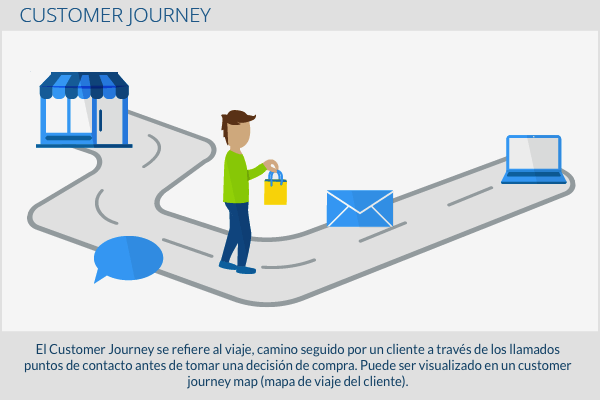The Customer Journey refers to the journey, the path followed by a customer through so-called contact points before making a purchase choice. It can be viewed on a customer journey map.
Definition
Generally, a consumer does not decide to buy immediately after meeting or seeing a product for the first time. Customers typically look at a product or brand multiple times before deciding on an action, known in marketing as touch points. So he customer journey or customer journey comes or goes from these touch points.
In offline commercial promotion, it is very difficult to trace a customer journey, because it is generally impossible to know where a store customer found, and why they are there. Possible reasons could be a recommendation from a family member or friend, a flyer, or a newspaper ad. You may be able to find out why with a qualitative survey. However, carrying out these surveys would incur costs, both monetary and time. New approaches such as "Instore-Tracking" through "Beacons" or Wi-Fi monitoring are making it easier for companies to physical stores rebuilding the customer journey inside a store.
On the Internet, however, the contact points of any potential customer for a product or service can be accurately tracked with the right tracking tools, even through many channels. You can see what precisely the customer journey means here.
Example of a customer journey
An amateur gardener discovers a new gardening device that he finds interesting in an opinion forum. In a DIY store brochure that was included with your newspaper, discover some basic facts about the product, such as technical characteristics and price. Your interest intensifies. You search for the product on the Internet and want to know if other hobby gardeners have already reported their experience with the device. Use a portal of valuations or reviews. You are inspired by the experiences of others and you want to buy the device. Visit the manufacturer's website to find out where you can buy it, and in short then go to one of the online stores and order the product.
In this example, there are multiple touchpoints.
Opinion forum DIY shop brochure in newspaper Internet rating portal Manufacturer web portal Authorized dealer online shop
Adequate contact points
Different types of communication media can be considered as points of interaction and contact.There are commercial promotion media such as television commercials, radio commercials, newspaper inserts, billboards, commercial promotion columns, and similar items from the classic commercial promotion. However, these alternatives for commercial promotion cannot be traced. Therefore, the contact points on the Internet are more interesting for online marketing, such as opinion forums, experience or review portals, blogs, manufacturers' sites, banners and similar advertising materials. They can be made fully visible in the form of customer journeys.
Phases of the customer journey
There are different approaches to how to divide the phases of the customer journey. However, they all share a common idea: it can be assumed that the purchase decision is not usually immediate. First, the product must be made known to the target group. In the next step, interest in the product must be created. Only some time after the information has been received will a desire for the product emerge, ideally leading to action. In this case, we speak of a conversion. The principle is similar to the AIDA Model.
The expected action does not necessarily have to be a purchase or an order. Even signing up for an email newsletter or requests for information may be a reasonable goal, depending on individual corporate goals.
Purpose of the customer journey
The purpose of examining the customer journey is find out more about consumer behavior. Since the touchpoints involved are visible, you can derive from them how to best design the customer path to get action from any potential buyer with greater certainty. In addition, you can review how specific touchpoints relate to each other.
Customer journey analysis
Tracking tools, such as cross-device tracking or cross-device tracking, can help in analyzing the customer journey. Cross device tracking is a tool specifically useful to get information about the customer journey, as you can find out which device the potential customer used to access the site and in what order.
problems
Depending on the data available, it can be difficult to figure out precisely which touchpoint led to a conversion. Each point of contact usually contributes to some extent to the customer's purchase decision. If the consumer had not noticed the product at the first point of contact, it is feasible that he would never have known of its existence. Without the positive ratings on the internet, the interest could have remained at a level not high enough to be followed by a stock. An exact determination of the cause in this area is difficult.
At the same time, customer journey analysis can cause problems in online marketing due to data protection. The customer journey cannot be accurately reconstructed if a user deletes their cookies or uses a tool that prevents tracking, and the combination of different data is only allowed in certain circumstances.




